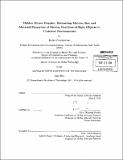Hidden object doppler : estimating motion, size and material properties of moving non-line-of-sight objects in cluttered environments
Author(s)
Pandharkar, Rohit (Rohit Prakash)
DownloadFull printable version (13.54Mb)
Alternative title
Estimating motion, size and material properties of moving non-line-of-sight objects in cluttered environments
Other Contributors
Massachusetts Institute of Technology. Dept. of Architecture. Program in Media Arts and Sciences.
Advisor
Ramesh Raskar.
Terms of use
Metadata
Show full item recordAbstract
The thesis presents a framework for Non-Line-of-Sight Computer Vision techniques using wave fronts. Using short-pulse illumination and a high speed time-of-flight camera, we propose algorithms that use multi path light transport analysis to explore the environments beyond line of sight. What is moving around the corner interests everyone including a driver taking a turn, a surgeon performing laparoscopy and a soldier entering enemy base. State of the art techniques that do range imaging are limited by (i) inability to handle multiple diffused bounces [LIDAR] (ii) Wavelength dependent resolution limits [RADAR] and (iii) inability to map real life objects [Diffused Optical Tomography]. This work presents a framework for (a) Imaging the changing Space-time-impulse-responses of moving objects to pulsed illumination (b) Tracking motion along with absolute positions of these hidden objects and (c) recognizing their default properties like material and size and reflectance. We capture gated space-time impulse responses of the scene and their time differentials allow us to gauge absolute positions of moving objects with knowledge of only relative times of arrival (as absolute times are hard to synchronize at femto second intervals). Since we record responses at very short time intervals we collect multiple readings from different points of illumination and thus capturing multi-perspective responses allowing us to estimate reflectance properties. Using this, we categorize and give parametric models of the materials around corner. We hope this work inspires further exploration of NLOS computer vision techniques.
Description
Thesis (S.M.)--Massachusetts Institute of Technology, School of Architecture and Planning, Program in Media Arts and Sciences, 2011. Cataloged from PDF version of thesis. Includes bibliographical references (p. 111-117).
Date issued
2011Department
Program in Media Arts and Sciences (Massachusetts Institute of Technology)Publisher
Massachusetts Institute of Technology
Keywords
Architecture. Program in Media Arts and Sciences.